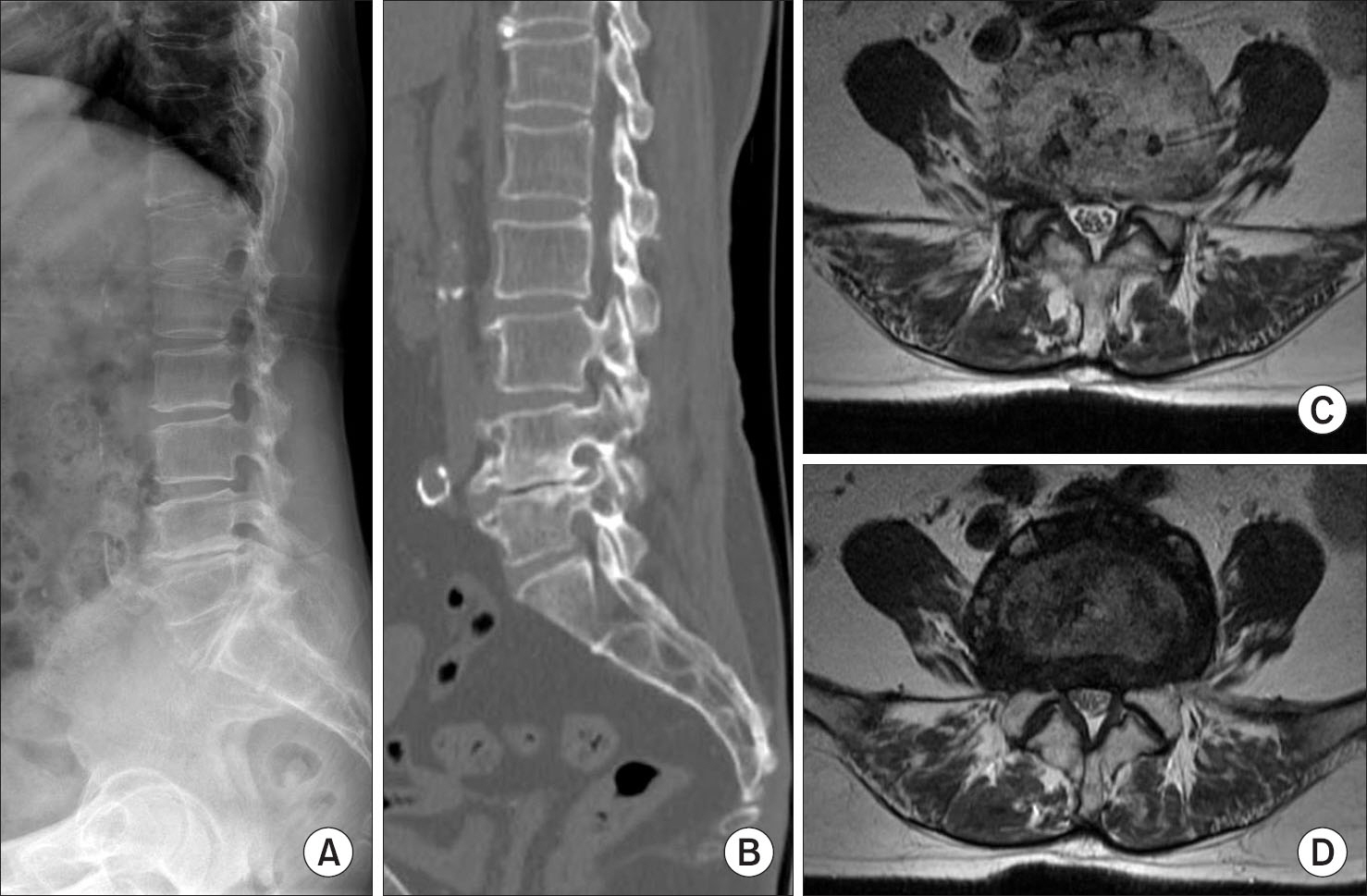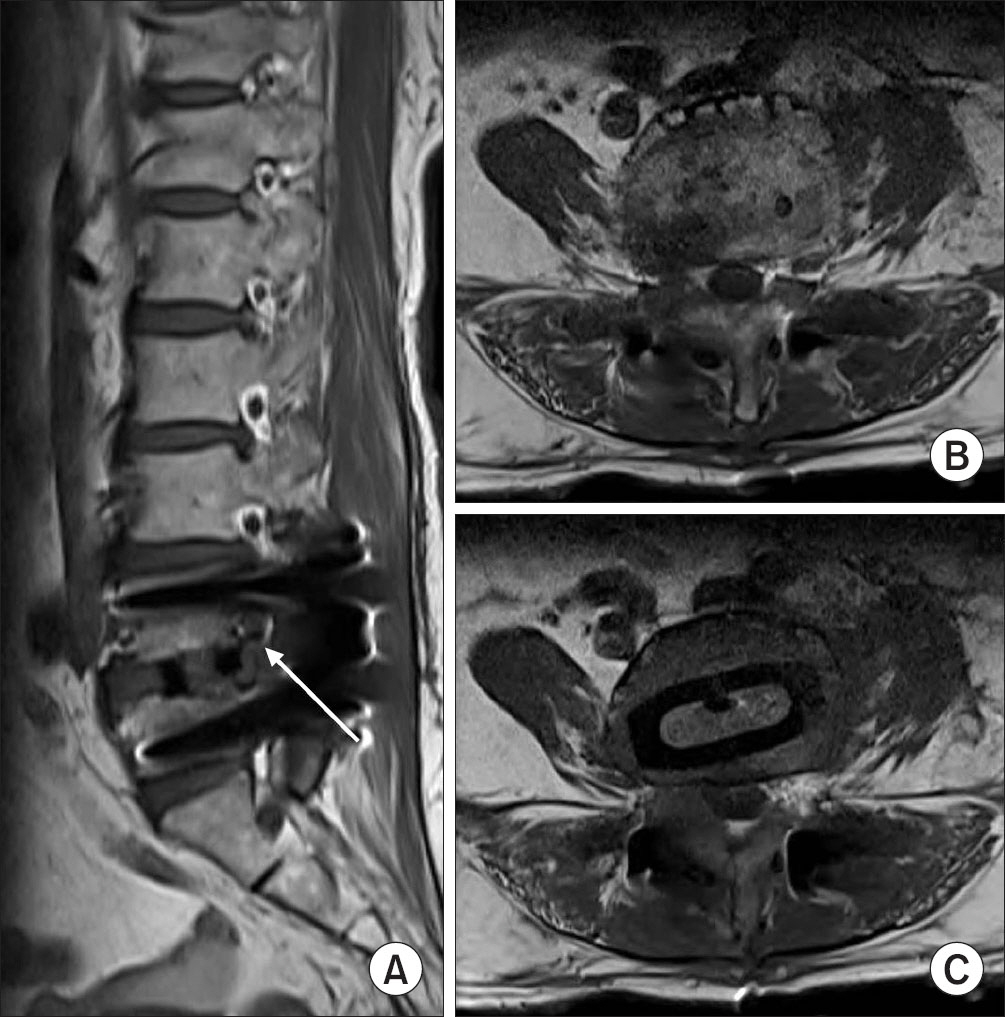J Korean Orthop Assoc.
2017 Jun;52(3):285-289. 10.4055/jkoa.2017.52.3.285.
Contralateral Nerve Root Compression after Direct Lateral Lumbar Interbody Fusion
- Affiliations
-
- 1Department of Orthopaedic Surgery, Pusan National University School of Medicine, Busan, Korea. jungsublee@pusan.ac.kr
- KMID: 2384560
- DOI: http://doi.org/10.4055/jkoa.2017.52.3.285
Abstract
- Direct lateral lumbar interbody fusion (DLIF) has been introduced as an effective new thoracolumbar fusion technique for patients with degenerative lumbar diseases. DLIF associated with easy-to-learn, high fusion rate, improved restoration of spinal alignment, and early patient mobilization due to minimally invasive nature. However, ipsilateral L2-L5 nerve root irritation and injury are well-known complications. However, damage to the contralateral nerve root has been rarely reported and, to the best of our knowledge, there have not been any reports about contralateral nerve root injury after DLIF in Korea. Thus, we report a case of contralateral nerve root compression due to osteophyte from the lower endplate of the vertebral body and position of intervertebral cage after DLIF.
MeSH Terms
Figure
Reference
-
1. McAfee PC, Regan JJ, Geis WP, Fedder IL. Minimally invasive anterior retroperitoneal approach to the lumbar spine. Emphasis on the lateral BAK. Spine (Phila Pa 1976). 1998; 23:1476–84.2. Ozgur BM, Aryan HE, Pimenta L, Taylor WR. Extreme lateral interbody fusion (XLIF): a novel surgical technique for anterior lumbar interbody fusion. Spine J. 2006; 6:435–43.
Article3. Oliveira L, Marchi L, Coutinho E, Pimenta L. A radiographic assessment of the ability of the extreme lateral interbody fusion procedure to indirectly decompress the neural elements. Spine (Phila Pa 1976). 2010; 35:S331–7.
Article4. Sharma AK, Kepler CK, Girardi FP, Cammisa FP, Huang RC, Sama AA. Lateral lumbar interbody fusion: clinical and radiographic outcomes at 1 year: a preliminary report. J Spinal Disord Tech. 2011; 24:242–50.5. Rodgers WB, Gerber EJ, Patterson J. Intraoperative and early postoperative complications in extreme lateral interbody fusion: an analysis of 600 cases. Spine (Phila Pa 1976). 2011; 36:26–32.6. Cappuccino A, Cornwall GB, Turner AW. . Biomechanical analysis and review of lateral lumbar fusion constructs. Spine (Phila Pa 1976). 2010; 35:S361–7.
Article7. Kepler CK, Sharma AK, Huang RC. . Indirect foraminal decompression after lateral transpsoas interbody fusion. J Neurosurg Spine. 2012; 16:329–33.
Article8. Houten JK, Alexandre LC, Nasser R, Wollowick AL. Nerve injury during the transpsoas approach for lumbar fusion. J Neurosurg Spine. 2011; 15:280–4.
Article9. Lykissas MG, Aichmair A, Hughes AP. . Nerve injury after lateral lumbar interbody fusion: a review of 919 treated levels with identification of risk factors. Spine J. 2014; 14:749–58.
Article10. Papanastassiou ID, Eleraky M, Vrionis FD. Contralateral femoral nerve compression: an unrecognized complication after extreme lateral interbody fusion (XLIF). J Clin Neurosci. 2011; 18:149–51.
Article
- Full Text Links
- Actions
-
Cited
- CITED
-
- Close
- Share
- Similar articles
-
- Minimally Invasive Lateral Lumbar Interbody Fusion: Indications, Outcomes and Complications
- Uniportal Endoscopic Lumbar Interbody Fusion
- Pearls and Pitfalls of Oblique Lateral Interbody Fusion: A Comprehensive Narrative Review
- Minimally Invasive Lateral Lumbar Interbody Fusion: Surgical Technique and Review
- Morphometric Analysis of the Ureter with Respect to Lateral Lumbar Interbody Fusion Using Contrast-Enhanced Computed Tomography




